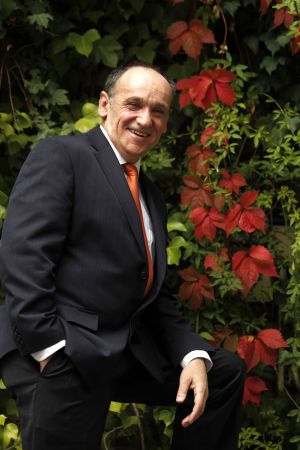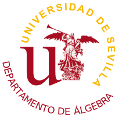Alicia Rivera El País
“Estamos rodeados de datos secretos encriptados”
 Si la encriptación de información y el descifrado de claves parece algo misterioso, propio de espías y de altos secretos militares o diplomáticos, lo que hace Ignacio Luengo casi supera a la imaginación: encriptación poscuántica. Se trata, explica este matemático, de investigar sistemas para ocultar datos y claves que resistan el cálculo de los ordenadores, pero no de los actuales, sino de los que tal vez algún día se logren construir, basados en la mecánica cuántica. “Ahora, la principal amenaza para la seguridad en Internet es el trabajo de los ingenieros y físicos con la computación cuántica”, dice, porque esas futuras máquinas podrían destripar cualquier código actual. “La criptografía nos rodea por todas partes, no es cierto que sea cosa de diplomáticos y militares”, recalca. Saca de la cartera una tarjeta de crédito con chip. “Lo que está escrito aquí es el número secreto codificado… Pero también los códigos cuando compramos por Internet, o los derechos legales de una canción o una fotografía con marca de agua… todo el tráfico de datos va cifrado…”.
Si la encriptación de información y el descifrado de claves parece algo misterioso, propio de espías y de altos secretos militares o diplomáticos, lo que hace Ignacio Luengo casi supera a la imaginación: encriptación poscuántica. Se trata, explica este matemático, de investigar sistemas para ocultar datos y claves que resistan el cálculo de los ordenadores, pero no de los actuales, sino de los que tal vez algún día se logren construir, basados en la mecánica cuántica. “Ahora, la principal amenaza para la seguridad en Internet es el trabajo de los ingenieros y físicos con la computación cuántica”, dice, porque esas futuras máquinas podrían destripar cualquier código actual. “La criptografía nos rodea por todas partes, no es cierto que sea cosa de diplomáticos y militares”, recalca. Saca de la cartera una tarjeta de crédito con chip. “Lo que está escrito aquí es el número secreto codificado… Pero también los códigos cuando compramos por Internet, o los derechos legales de una canción o una fotografía con marca de agua… todo el tráfico de datos va cifrado…”.
Luengo ha dado una conferencia en la Fundación Ramón Areces, en Madrid, precisamente sobre las hazañas en encriptación del matemático británico Alan Turing, padre de los ordenadores modernos, en unas jornadas celebradas por su centenario. Tras la charla rechaza el café y, de momento, solo bebe agua. “Turing era un genio y su trabajo en criptografía fue fundamental, hasta el punto de que se ha calculado que la II Guerra Mundial se acortó en al menos dos años gracias a que los aliados lograron leer casi sistemáticamente todo el tráfico cifrado de los alemanes, con su máquina Enigma”, señala Luengo. “Turing fue el que descifró el código e hizo comprensibles los mensajes que se cifraban con Enigma”.
Lamentablemente, añade, tras la guerra, los británicos destruyeron todo el material y se clasificaron los documentos de Turing (algunos se han desclasificado este mismo año). “Y todo eso lo logró con matemáticas, con talante matemático…”, dice este catedrático de Álgebra de la Universidad Complutense. A sus 59 años, dice que su vocación matemática fue algo tardía y que eligió esa carrera porque le resultaba la más sencilla.
“Sí, los códigos obsesionan, como muchas cosas en matemáticas, porque al fin y al cabo nuestro laboratorio es nuestro cerebro, así que uno lo lleva a todas partes”, añade, ya con una taza de café. “Pero tampoco se puede vivir obsesionado 24 horas al día 365 días al año”.
¿Existe el código imbatible? “Sí, uno en que la longitud de la clave es igual a la longitud del mensaje y si la clave se elige aleatoriamente, es indescifrable”, responde este especialista. “Pero es poco práctico”, añade, “porque si tienes que decirle al otro la clave te cuesta lo mismo decirle el mensaje entero; solo se usa cuando los dos interlocutores pueden ponerse de acuerdo de antemano con la clave, como el teléfono rojo entre los presidentes estadounidense y soviético en la guerra fría”.
La verdad es que los códigos que se usan normalmente son muy buenos…, explica Luengo. Lo que falla es el protocolo, lo que se hace al usarlos: “Hay un virus informático, por ejemplo, que se mete en tu ordenador y almacena lo que tecleas; es muy peligroso porque alguien puede cazar tus números de tarjeta y claves, por muy secretas que sean”. Él aconseja, cuando se usa en Internet, escribir la clave en otro documento, arrastrar los números con el ratón e importarla a la página web.
Ignacio Luengo es Catedrático de Álgebra de la Universidad Complutense y presidente de la Comisión Científica de la RSME.

